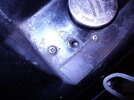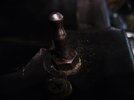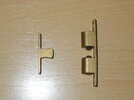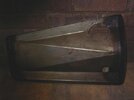Thank you, everyone. This has certainly become a fulsome discussion of an obscure topic. It is particularly interesting because it reflects the fact that much of the Series "D" was put together on the fly, on the shop floor, rather than the drawing board.
Don Morris' contribution likely solves the mystery of the source of my seat. The measured length, the shape and location of holes, and the metal folds all line up. Don's seat pan was sourced in 1974, which is also the rough age of the one we have here. Alas, this pan will be too short, and will certainly not fit an enclosed model.
All the photes of latch solutions are very helpful. Even if many of these are for securing to the seat frame rails of the open model, having all this here makes the discussion complete.
In that regard, we have yet another home grown solution on an open model here in Ontario. On this bike, there is a metal strap welded across the seat rails with two holes drilled. The seat is simple bolted down to this bridge by screws through the bottom of the pan. Unfortunately, this simple bodge negates the handy feature of being able swing the seat up for quick access to the oil filler. But, it is secure!
The conclusions and path forward are clear. The seat pan I have won't cut it. We'll need a longer base that clears the enclosure's wheel hump. We'll need the seat to sit down on the enclosure. Finally, we'll fashion a latch, or some form of pins and grommets to stop lateral movement. Off to the hardware store we go! Here in Canada we have Home Depot, a gigantic franchise of superstores open 24/7. I've spent many an hour there solving just this sort of problem. Cheers, all.




